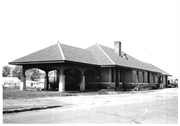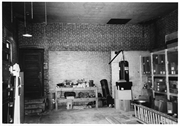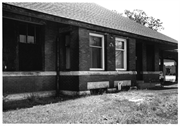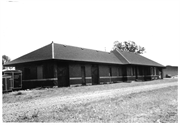426 Tainter Avenue
| Historic Name: | Chicago, St. Paul, Minneapolis and Omaha Railroad Passenger Station |
|---|---|
| Reference Number: | 07000588 |
| Location (Address): | 426 Tainter Avenue |
|---|---|
| County: | Barron |
| City/Village: | Rice Lake |
| Township: |
| Chicago, St. Paul, Minneapolis & Omaha Railroad Passenger Station 426 Tainter Avenue, Rice Lake, Barron County Architect: Horace P. Padley Date of construction: 1909 The Chicago, St. Paul, Minneapolis & Omaha Railroad Passenger Station in Rice Lake was built in 1909 replacing an earlier frame depot built by the "Omaha Road." The new station's construction was prompted by Rice Lake's robust growth in the post-1900 period when the city was transitioning from a major lumbering center in Northwest Wisconsin to a farming and trading hub for Barron County. Its construction also signaled the continuing importance of railroading as the major mode of transportation serving the community's commercial, manufacturing, and agricultural needs, as well as a growing passenger market. County-wide population nearly doubled between 1890 and 1909. After the Knapp, Stout & Company closed out its Rice Lake logging operations in 1900, immigrants from Scandinavia, Germany, Bohemia, Poland, and Switzerland established farms in the "Cutover." In just ten years from 1900 to 1910 the number of farms in Barron County grew from 1842 to 3842. In later decades the new passenger station greeted a continuing flow of Cutover settlers, as well as traveling salesmen and North Country tourists. The Omaha Road operated the station from 1909 until 1957 when the line was leased by the Chicago and North Western Railroad. Passenger service to Rice Lake was discontinued in 1961. In 1972 the Chicago and North Western bought all of the assets of the Omaha Road and in 1979 closed the station. The St. Paul, Minneapolis & Omaha Railroad Passenger Station is a well-preserved example of a "combination" depot equipped to house both passenger services and freight operations in one building. The building was designed by Omaha Road architect Horace P. Padley of St. Paul. The station has a Prairie School Style influenced design with an extended hipped-roof form, deep eaves, an attached platform shed, horizontal window groups, and the stone belt course. Its masonry construction, substantial size, fine interior appointments, and the inclusion of a separate women's waiting room indicate the importance this station had for the Omaha Road system when it was constructed. The depot is privately owned.
|
| Period of Significance: | 1909-1961 |
|---|---|
| Area of Significance: | Architecture |
| Area of Significance: | Transportation |
| Applicable Criteria: | Architecture/Engineering |
| Applicable Criteria: | Event |
| Historic Use: | Transportation: Rail-Related |
| Architectural Style: | Late 19th And Early 20th Century American Movements |
| Resource Type: | Building |
| Architect: | Padley, Horace P. |
| Historic Status: | Listed in the National Register |
|---|---|
| Historic Status: | Listed in the State Register |
| National Register Listing Date: | 06/21/2007 |
| State Register Listing Date: | 10/13/2006 |
| Number of Contributing Buildings: | 1 |
|---|---|
| Number of Contributing Sites: | 0 |
| Number of Contributing Structures: | 0 |
| Number of Contributing Objects: | 0 |
| Number of Non-Contributing Buildings: | 0 |
| Number of Non-Contributing Sites: | 0 |
| Number of Non-Contributing Structures: | 0 |
| Number of Non-Contributing Objects: | 0 |
| National Register and State Register of Historic Places, State Historic Preservation Office, Wisconsin Historical Society, Madison, Wisconsin |





